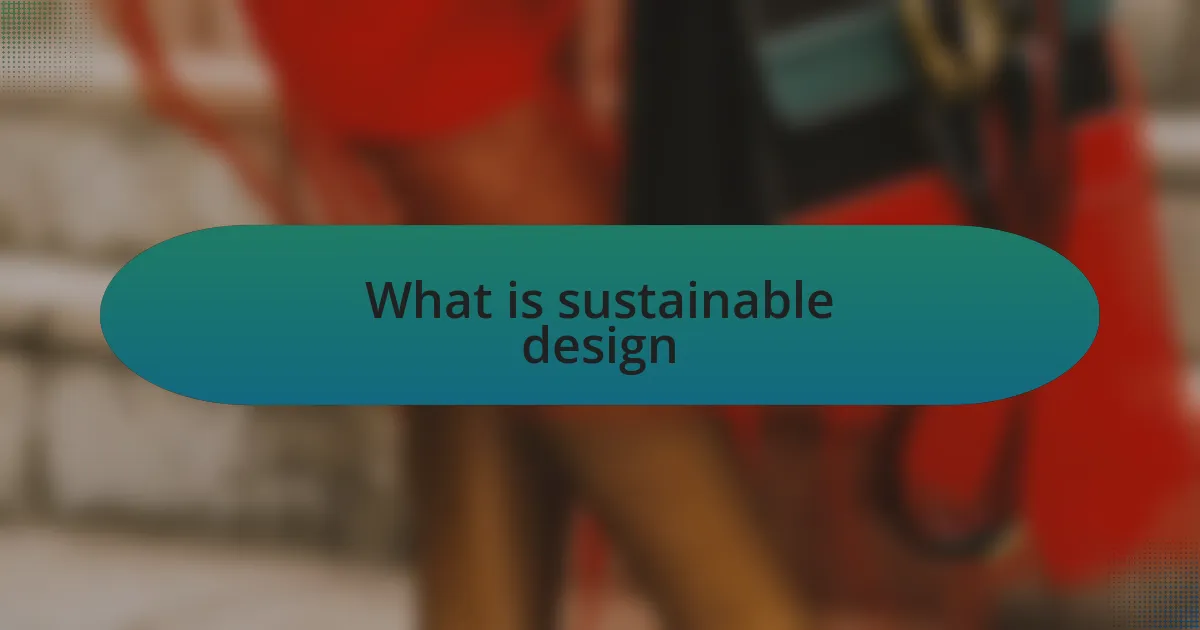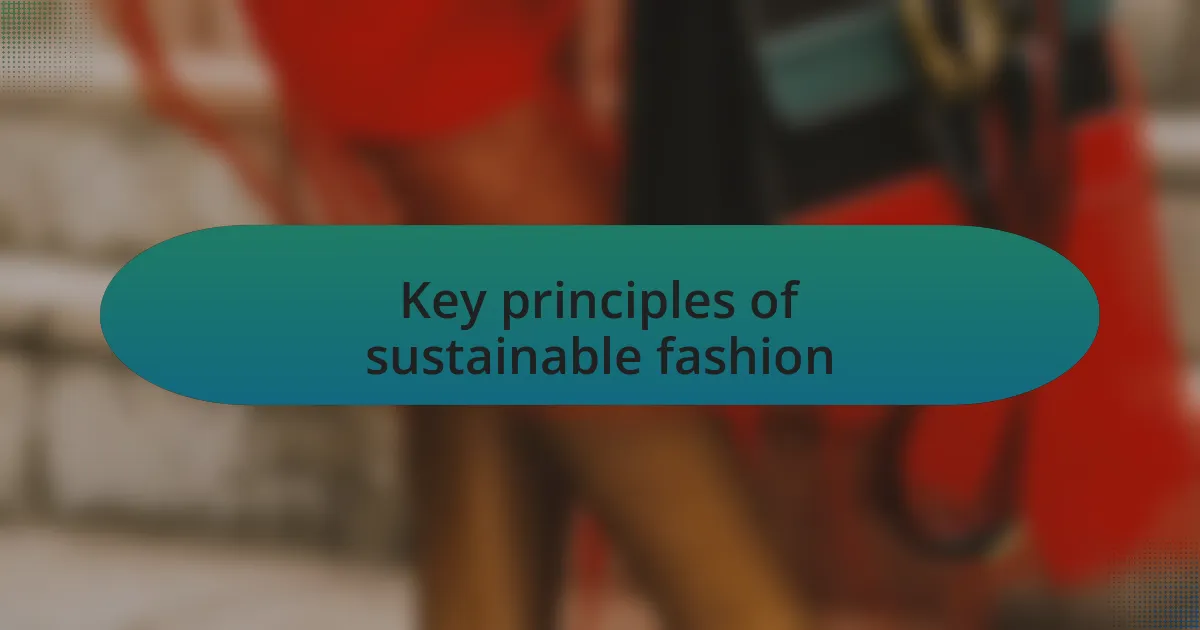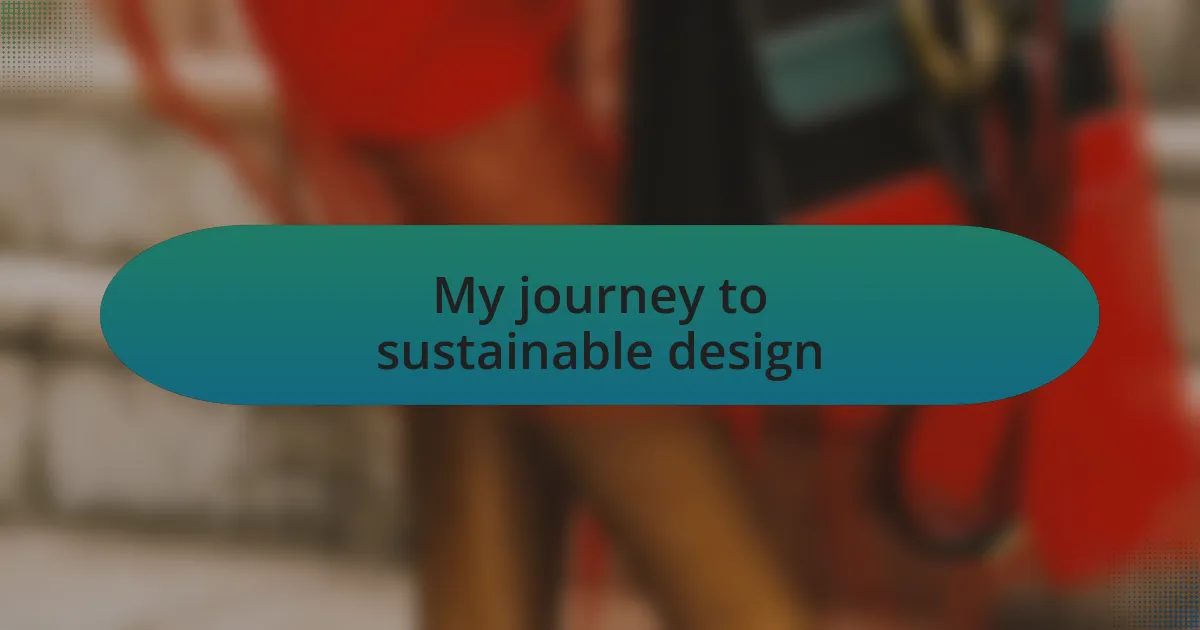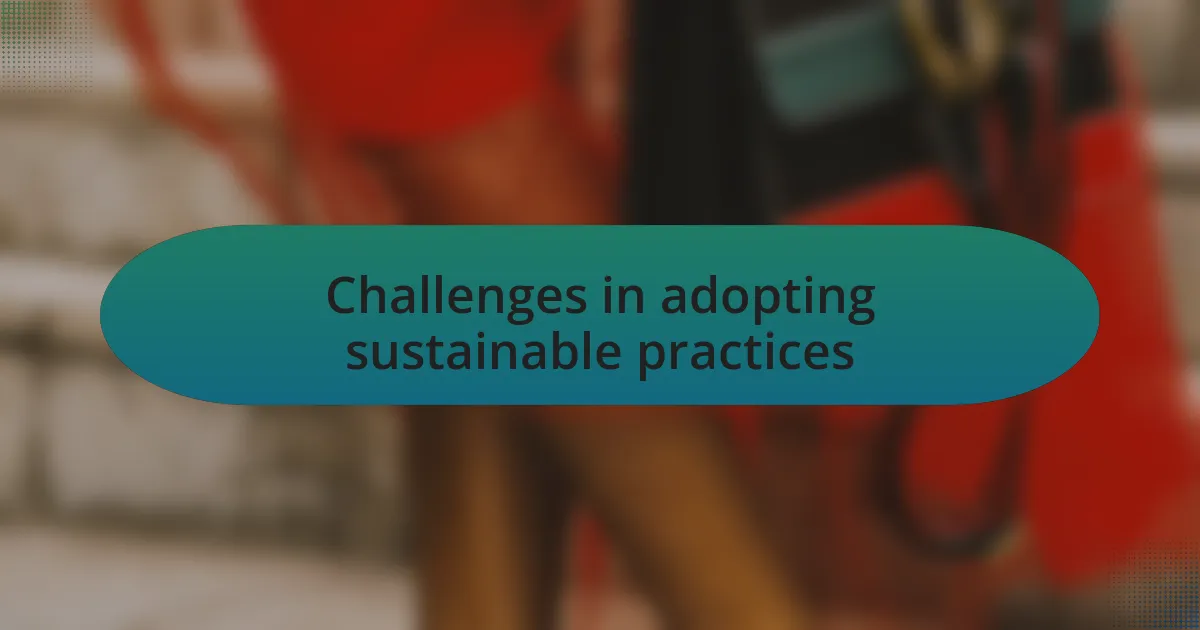Key takeaways:
- Sustainable design emphasizes environmental responsibility and ethical practices, transforming both products and the designer’s mindset.
- Key principles include ethical sourcing, eco-friendly materials, and longevity in design to reduce waste and enhance consumer connection.
- Challenges in adopting sustainable practices include limited availability of eco-friendly materials, high costs, and gaps in consumer awareness.
- Trends such as upcycling, transparency in supply chains, and biodegradable materials are shaping the future of sustainable fashion.

What is sustainable design
Sustainable design is an approach that prioritizes environmental responsibility by minimizing harm and maximizing benefits throughout a product’s lifecycle. For me, it’s not just a trend; it’s a commitment to ensuring the fashion choices we make respect the planet and the people on it. When I think about this, I often wonder, how can we create beauty while supporting a healthier Earth?
In my own experience, I’ve seen how opting for sustainable materials, like organic cotton or recycled polyester, can transform both the garment and the designer’s ethos. I recall a project where I chose biodegradable fabrics. The satisfaction of presenting a collection that not only looked good but also felt good to produce was a turning point for me. It made me realize that every thread we weave can tell a story of care and responsibility.
Sustainable design goes beyond merely using “green” materials; it also encompasses ethical labor practices and community engagement. Have you ever considered where your clothing comes from? I believe that understanding the impact of our choices can lead to a deeper connection with the items we wear. Every decision counts, and embracing sustainable practices can significantly impact the fashion industry and the world at large.

Importance of sustainable practices
Adopting sustainable practices in fashion is essential not just for the environment, but for our collective future. I often think back to a time when I was part of a workshop that focused on waste reduction. It was eye-opening to see how much fabric is discarded, and it made me question: how can we justify that in an industry that thrives on creativity? Recognizing the importance of reducing waste has reshaped my design philosophy to prioritize reusing materials.
Moreover, embracing sustainability fosters innovation in design. I remember a project where we experimented with upcycling materials, turning what was once considered trash into a beautiful, cohesive collection. The excitement of transforming these forgotten pieces into something desirable was contagious. It made me realize that sustainable practices can lead to unique aesthetics that not only stand out but also tell a meaningful story about conscious choices.
On a broader scale, sustainable practices can significantly shift consumer behavior towards more responsible shopping. Have you ever felt the pride of wearing something that supports ethical practices? When consumers are educated about the impact of their purchases, it encourages them to make informed decisions. This creates a ripple effect, inspiring others to think critically about their fashion choices, ultimately propelling the industry towards a more sustainable future.

Key principles of sustainable fashion
When we talk about the key principles of sustainable fashion, one that stands out is the concept of ethical sourcing. I remember discovering the story behind a small brand that sourced its cotton from local farmers. It struck me how that not only supported the community but also created a deeper connection to the garments we wear. Have you ever thought about where your clothes come from? This principle encourages us to be mindful of our choices and prioritize brands that respect both the people and the planet.
Another crucial principle is the use of eco-friendly materials. I often reflect on my own experiences experimenting with organic fabrics, which made me appreciate the difference in texture and breathability. When I wore those pieces, it felt good to know that I was making a choice that was kinder to the environment. Isn’t it fascinating how material choices can echo our values as consumers? Opting for sustainable materials can lead to a healthier planet while still allowing creativity to shine through.
Lastly, the idea of longevity in design plays a pivotal role in sustainable fashion. I’ve had pieces in my wardrobe that have lasted for years, and there’s something special about that history. Sometimes I think about how consumer culture pressures us to seek the latest trends, but what if we celebrated timeless designs instead? By creating products that stand the test of time, we can reduce unnecessary waste and cultivate a deeper appreciation for our clothing, ultimately redefining our relationship with fashion.

Trends in sustainable fashion design
Trendy practices in sustainable fashion design are increasingly focused on upcycling, where old materials are transformed into new creations. I remember visiting a boutique that showcased a stunning collection made entirely from discarded fabrics. The designer shared how each piece carried its own story, making them not just garments but conversation starters. Have you ever felt a sense of connection to a garment because of its backstory?
Another notable trend is the growing emphasis on transparency within brands. I recently read a report on a company that openly shared their entire supply chain process, from sourcing to production. It was refreshing to see a brand taking responsibility and building trust with consumers. How often do we pause to appreciate the complexity behind our favorite pieces? This transparency invites us to become informed consumers, encouraging us to demand accountability in the industry.
Lastly, there’s a surge in the popularity of biodegradable materials as designers search for solutions that won’t linger in landfills for decades. I can’t help but think about the thrill of wearing something that will eventually return to the earth. It’s a comforting thought that resonates with my belief in circular fashion. Could embracing biodegradability redefine our relationship with clothing, allowing us to wear our values quite literally?

My journey to sustainable design
As I embarked on my journey towards sustainable design, it started with a simple question: how can I make a difference in this vibrant industry? The first step was experimenting with vintage materials I had gathered over the years. I remember the excitement I felt when I transformed an old denim jacket into a trendy bag – it was like breathing new life into something that once was forgotten. How many stories could I tell through these pieces?
Gradually, I started seeking out local artisans who shared my passion for sustainability. Collaborating with them not only expanded my creative horizons but also deepened my appreciation for the craftsmanship behind each piece. I vividly recall attending a workshop where we learned to dye fabrics using natural elements like turmeric and avocado pits. It reignited my enthusiasm for fashion, reminding me that beauty can stem from nature itself. Have you ever tried creating something from scratch, only to discover a hidden talent?
Reflecting on my path, I realize that the shift towards sustainable design is as much about embracing change as it is about influencing others. I’ve seen firsthand how conversations around sustainability can spark new ideas and inspire innovation. When I presented my first collection at a local showcase, the joy on my peers’ faces was palpable. It struck me then that every small step toward sustainability can create ripples in the fashion community, encouraging others to follow suit. Isn’t it remarkable how our individual choices can collectively reshape the industry?

Challenges in adopting sustainable practices
When it comes to adopting sustainable practices, one significant challenge is the availability of eco-friendly materials. I remember a time when I scoured local shops, only to find limited options that were both stylish and sustainable. It often left me questioning: how can I keep my designs fresh if I can’t access the resources I need? This scarcity can stifle creativity and limit the potential for innovation in our designs.
Another hurdle I’ve faced is the cost associated with sustainable materials and processes. It was surprising to realize that while creating an eco-conscious piece, my expenses often soared. I found myself pondering whether consumers would be willing to pay a premium for sustainability. Balancing affordability with quality is a tightrope walk, and it makes me wonder: how much are we, as designers and consumers, willing to invest in a sustainable future?
Moreover, there can be a gap in consumer awareness regarding the benefits of sustainable fashion. I vividly recall a discussion at a pop-up event where many attendees were unaware of the environmental impact of fast fashion. Engaging them in meaningful conversations was rewarding yet challenging. It made me reflect: How do we bridge this knowledge gap? The dialogue around sustainability needs to continue evolving to inspire better choices among consumers.